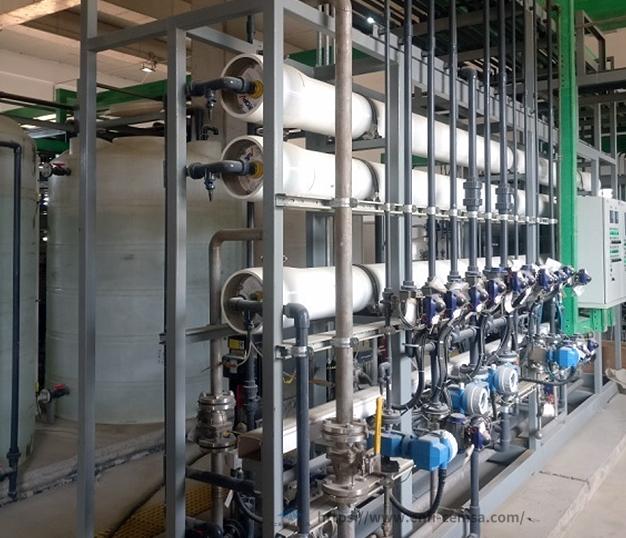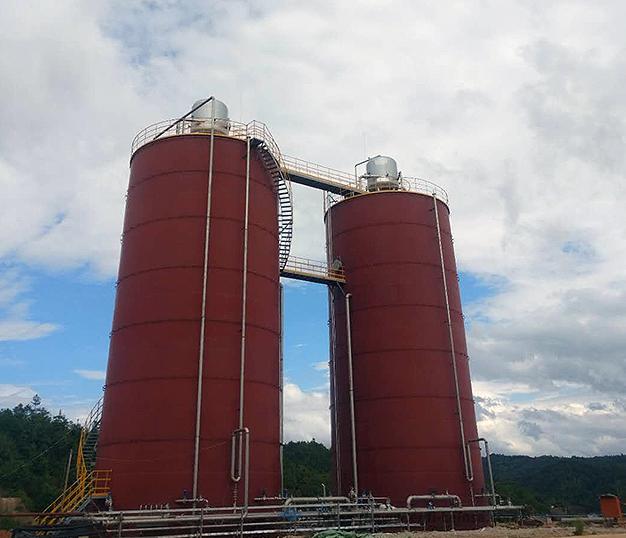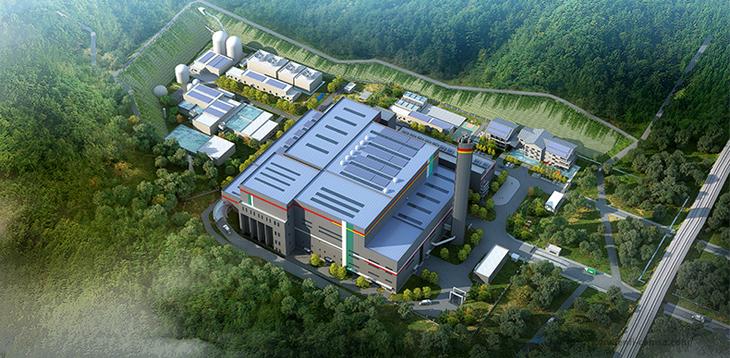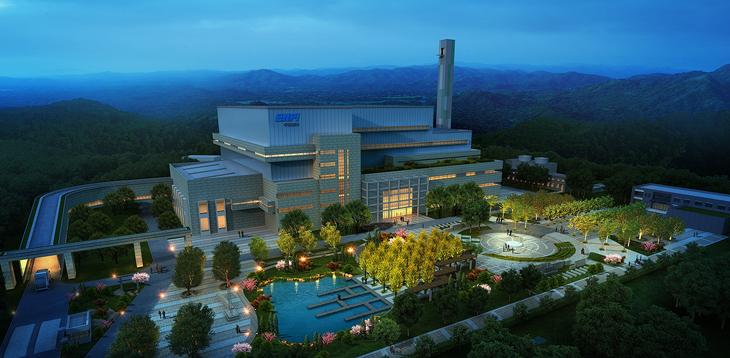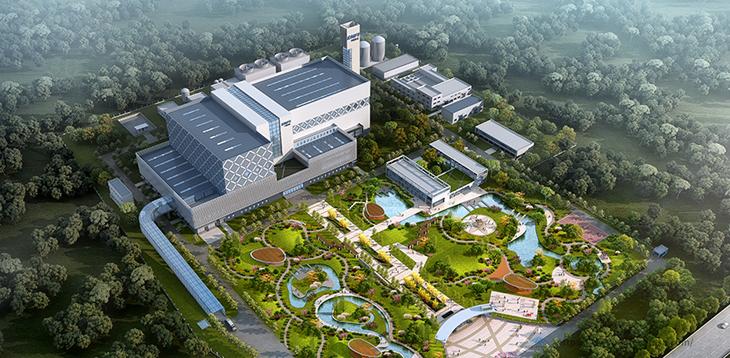首页 > 产品中心 > Industrial wastewater treatment > Whole-set Equipment for Domestic Waste Leachate Treatment
产品简介
Whole-set Equipment for Domestic Waste Leachate Treatment
Domestic waste leachate is sourced from the liquid seeped from waste storage bins, flushing water from waste dumping area and vehicles, etc. It’s a kind of highly concentrated organic wastewater with high chroma and foul smell.
A complete set of equipment is used to treat domestic waste leachate, comprising the devices for pre-treatment + conditioning tank + anaerobic treatment + MBR + NF + RO + concentrate reduction. The whole-set equipment are applicable to the leachate treatment station of WtE plants.
A complete set of equipment is used to treat domestic waste leachate, comprising the devices for pre-treatment + conditioning tank + anaerobic treatment + MBR + NF + RO + concentrate reduction. The whole-set equipment are applicable to the leachate treatment station of WtE plants.
 规格系列:be designed and customized according to engineering requirements
规格系列:be designed and customized according to engineering requirements
 处理能力:According to the design capacity of WtE plants, corresponding leachate treatment systems can handle 150m³/d, 200m³/d, 250m³/d, 300m³/d and combined-volume domestic waste leachate.
处理能力:According to the design capacity of WtE plants, corresponding leachate treatment systems can handle 150m³/d, 200m³/d, 250m³/d, 300m³/d and combined-volume domestic waste leachate.
 适用领域:Domestic waste to power plants
适用领域:Domestic waste to power plants
 服务电话+86 13521339794
服务电话+86 13521339794 

 enfi.cemsa@gmail.com
enfi.cemsa@gmail.com
优势特点
 New high-efficiency anaerobic reactor, in which 80%~85% of CODcr contained in the leachate will be removed and refractory CODcr will be hydrolyzed and acidified, creating conditions for the subsequent aerobic biochemical reaction
New high-efficiency anaerobic reactor, in which 80%~85% of CODcr contained in the leachate will be removed and refractory CODcr will be hydrolyzed and acidified, creating conditions for the subsequent aerobic biochemical reaction
 The membrane advanced treatment and concentrate reduction system made up by “NF + RO + NF concentrate reduction device + RO concentrate reduction device” can realize the removal of divalent ions, humic acids, TDS, Cl- and other valence cations, ammonia nitrogen and total nitrogen, etc. in the leachate. The resulting water from the system can be recycled because it is up to the standards of makeup water for open recirculating cooling water system.
The membrane advanced treatment and concentrate reduction system made up by “NF + RO + NF concentrate reduction device + RO concentrate reduction device” can realize the removal of divalent ions, humic acids, TDS, Cl- and other valence cations, ammonia nitrogen and total nitrogen, etc. in the leachate. The resulting water from the system can be recycled because it is up to the standards of makeup water for open recirculating cooling water system.
工作原理
(1) The new efficient anaerobic reactor is comprised of water distribution system, reaction zone, 2-stage 3-phase separator, liquid-gas separation system, internal and external circulating system, etc. The water distribution system is situated at the bottom of the whole reactor into which inlet water and reclaimed water flow, and shoulders the task of even water distribution and agitation, forming a certain ascending flow rate and providing shearing force for the formation of granular sludge. Wastewater to be treated flows into the reactor from the bottom of anaerobic sludge blanket and is mixed with sludge in the sludge layer. Microorganisms in the sludge decompose organics in the wastewater and turn them into biogas. Biogas rises to the deflector plate at the bottom of separator and it is deflected to places around the plate. Then biogas passes through the aqueous layer to the gas chamber where it is concentrated and discharged by conduit. After deflecting, the aqueous-solid mixture goes to the settling area of separator, and sludge in wastewater is subjected to flocculation and settling as a result of gravity as its particle size gradually increases. After separation, the gas-liquid mixture rises to the gas-liquid separation system where biogas is discharged and the liquid returns to the bottom of reactor through conduit, forming the internal circulation and intensifying hydraulic stirring. Wastewater at the upper part of stage-1 three-phase separator is pumped to return pipes that are connected to inlet pipes at the bottom to continuously supply a stable ascending flow rate, intensify hydraulic stirring, increase the contact between sludge and wastewater, improve COD removal efficiency, and remarkably decrease sludge production. Treated wastewater is drained from the upper overflow weir.
(2) The advanced membrane filtration and concentrate quantity reduction system: in recent years, with increasingly strict requirements of environmental protection, requirements of filtrate recycling and zero emission are put forth for the waste leachate treatment system. The UF filtrate still contains a large amount of undecomposed organics, COD, BOD and other pollutants and thus cannot meet the standards of reclaimed water. Only by adopting the NF and RO membrane process, can the standards be met. But this will bring about the issue of concentrate treatment and disposal. NF concentrate mainly contains humic acid, fulvic acid and divalent ions. Bivalent salts can be removed through humic acid extraction, quantity reduction, coagulation and settling successively, and the supernate and NF filtrate enter the RO system to realize concentrate quantity reduction. The RO concentrate is mainly univalent salts. Given different features of these two concentrates, the NF concentrate quantity reduction membrane process is applied to NF concentrate while the DTRO process is applied to RO concentrate. During actual operation, one or two out of these two processes can be selected to connect in series to the NF and RO membrane process in the upstream so as to improve the system's recovery rate.
(2) The advanced membrane filtration and concentrate quantity reduction system: in recent years, with increasingly strict requirements of environmental protection, requirements of filtrate recycling and zero emission are put forth for the waste leachate treatment system. The UF filtrate still contains a large amount of undecomposed organics, COD, BOD and other pollutants and thus cannot meet the standards of reclaimed water. Only by adopting the NF and RO membrane process, can the standards be met. But this will bring about the issue of concentrate treatment and disposal. NF concentrate mainly contains humic acid, fulvic acid and divalent ions. Bivalent salts can be removed through humic acid extraction, quantity reduction, coagulation and settling successively, and the supernate and NF filtrate enter the RO system to realize concentrate quantity reduction. The RO concentrate is mainly univalent salts. Given different features of these two concentrates, the NF concentrate quantity reduction membrane process is applied to NF concentrate while the DTRO process is applied to RO concentrate. During actual operation, one or two out of these two processes can be selected to connect in series to the NF and RO membrane process in the upstream so as to improve the system's recovery rate.
技术参数
| S/N | Leachate treatment system capacity | Anaerobic reactor size | Design capacity of domestic WtE plant |
|---|---|---|---|
| 1 | 150m³/d | D×H=9.0m×18.0m | 500t/d feeding waste |
| 2 | 200m³/d | D×H=10.0m×20.0m | 600t/d feeding waste |
| 3 | 250m³/d | D×H=11.0m×22.0m | 800t/d feeding waste |
| 4 | 300m³/d | D×H=12.0m×24.0m | 1000t/d feeding waste |
应用业绩
相关推荐


